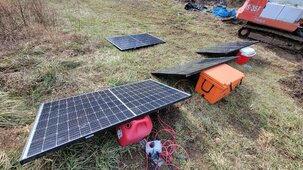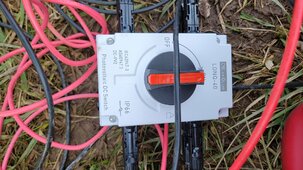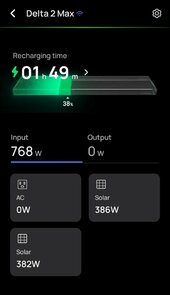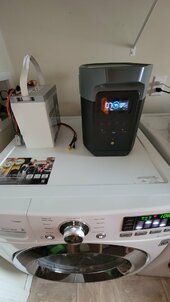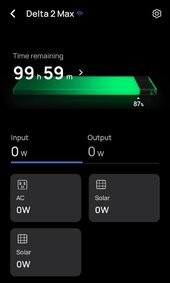I'm NOT using the "Load" output on the PowMr SCC, the configuration is the PowMr is connected to the Chins battery and the solar panels are then connected to the PowMr, I then have another set of leads coming directly off the battery and going to the solar input connection on the Dabbsson, in the case of this unit it's designed to be able to charge off a cars cigarette lighter or solar panels using the same port and the way the tech support guy i've been talking to has explained it, basically the port can tell if their is the varying voltage you would get from solar panels or not and if it doesn't detect that then it defaults to "car charging" mode where it limits the current to 8 amps so as to not exceed the capacity of a cigarette lighter port in a car which is whats capping my charge rate.
from what I can see on the Solix F3800 website it's supposed to do 2400 watts of solar so you wouldn't really get any expanded panel capacity doing things this way, but i'm not sure what input connections are on the F3800 the website doesn't have any good pictures or specs on that other then that the solar input in an XT60 connection, could you list all the different input ports and specs on them that you have?
Thanks so very much for the reply and the clarification. So to backup a bit, yes, despite the impressive 2400W DC input spec, there are a bunch of concurrent limitations on the Solix F3800's DC inputs that may make it very challenging to max out the inputs. I'm looking at ways to overcome them in an easier, more flexible way. The limitations are:
- first, it's 2x XT-60 inputs, 1200W max each one (and no one has verified yet whether they have independent MPPT tracking algorithms or not, so maybe a secondary issue right now).
-60V max voltage - which makes is fairly impossible to put any modern (i.e. built within last 12 years) 200+W panels in series (Voc typically above 32V). You have to wire all of them in parallel, increasing amps and the wire gauge needed.
-25A max amps - So any panels <48 Vmp are never going to hit 1200W because of the 25A limitation, Closest is 48V x 25A in parallel. But if saying using 37 Voc panels, that are actually operating closer to Vmp of say 32W, we only get 32x25 = 800W max
-10A max limit at 10-32V input - so I guess every mfr has something akin to the cig lighter limitation, but at least now I know WHY Anker has the limit. In fact they are rewarding all the Kickstarter supporters a stretch goal of the 12V 10A cig lighter charging cable, which would take a laughably long time to fill the 3840Wh batter. So I guess every mfr has this feature/limitation in a different way. EcoFlow's approach is to require you to use XT-60i instead of XT-60, otherwise it assumes 10A limit. Dabbsson is saying if the DC source does not behave like a solar panel V x I curve, it will assume 8A cig lighter limit. And now I understand why Anker has this 10A limit - but we don't know exactly how they implemented it, whether it's strictly below 32V or algorithmically like the Dabbsson may be doing. But I do have a worry with panels with Voc in the 32-37V range (most 200-300W panels), that Vmp under real conditions might drop below 32V and then we're stuck with a 10A limit or 320W max, just like you're seeing with your Dabbsson.
So my main interest was in using an inexpensive SCC as a primitive buck converter, allows me to wire up 3-4 panels in series at a higher 100-150 Voc and lower 8-12 Isc (which allow drops my wire gauge and line losses over a 40 ft run), dropping it at the battery terminals to 51-55V and higher 20-25A for only the short run to the Solix. Possibly one of three ways:
-SCC battery terminals directly to the Solix F3800 DC input (no 48V battery). The SCC thinks it's charging or floating a 48V battery, but it doesn't actually limit the amp or watt outputs from the solar panels, does it? But will the Solix MPPT tracker get confused and start hunting, or drop into "cig lighter" mode?
-SCC battery terminals to 48V battery, 48V battery terminals to Solix F3800 DC input. I now understand this is what you're doing. But if I understand this, the SCC terminals are still basically directly connected to the Solix F3800 as in the first possibility. But the 48V battery can act as a buffer - if the Solix drops to "cig lighter" mode, or is impeded by the 25A limitation, excess solar can go into the 48V battery. Does the converse work as well? If the Solix likes the 48V and tries to draw 25A, will it first get whateve rsolar output from the SCC, and then any difference will come out of the 48V battery? If so, what happens when the 49V battery is depleted - does a server rack battery have self-protection to keep it from being fully discharged?
-SCC battery terminals to 48V battery, SCC load terminals to Solix F3800. This was my original thought. So isn't the intent of SCC having the load terminals, is that it does prevent the load from continuing to pull from the 48V battery once the 48V battery is depleted? And also has some convenient scheduling algorithms to choose WHEN the Solix F3800 would be able draw down the 48V battery.
But if many SCC's have an 8-10A limit on the load terminals, will the Solix F3800 trip the overload protection if it tries to draw 25A? Or does it just end up pulling the SCC load limit without causing any issues? If that new PowMr actually does have a 30A load limit, would the Solix F3800 be able to draw full 25A from combination of solar + 48V battery from the load terminals?
Do any of the three scenario risk any damage to the SCC, if the Solix F3800 tries to draw 25A, but the panels and/or 48V battery can't supply that much?




